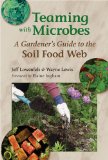| A frustrated reader takes a snow shovel to his lawn. |
| ABOUT US START IDEAS DO LESS USEFUL PLANTS PROJECTS VIEWS RESOURCES TOPICS |
|
|
|||
|
Question from Clyde in Minnesota: I'm being overwhelmed with mushrooms at home... not just a few but fairly organized rows of them about 1' wide and 6-8 feet long growing about 6+ inches above ground. For now about all I can do is take a snow shovel and scrape them off/out but I think I might be spreading the seeds of these nasty things even more...am I? Yes, it's rather shady in that area with a LARGE White Pine nearby. No, it's not mowed often. Is there a way to get rid of them 'shrooms'? They're light brown with heads(?) about 4" in diameter and stems about 1" diameter and there's thousands of them. The part of a mushroom that we see aboveground is its "fruit" and may contain thousands of tiny seeds called spores. Each spore grows a threadlike root when it falls to the ground, and the roots from many spores weave a huge underground web. Whenever two roots from different spores meet, they can join to make a new mushroom. To get rid of your mushrooms, you'd have to remove all the dirt that contains either roots or spores. (By the way, you may be spreading both when you shovel them 'shrooms.') Even if you found a poison that would wipe out this batch of mushrooms, airborne spores of the same species (or another species) could easily grow more mushrooms in the same spot as long as conditions are favorable. Your best long-term solutions? Change the environment or build a garden around the mushrooms. The latter might be easier, so let's start with it. STRATEGY #1: "I'm Growing These Mushrooms on Purpose" Stop mowing (and shoveling) the area. Put an edge around it to set it off from the "real" lawn. If you have a collection of cement bunnies or gnomes, arrange them artistically among the long grass and mushrooms. Casually mention to visitors how hard it was to get that colony of mushrooms to establish. Toss out a few fascinating facts about mushrooms (Did you know that the inner flesh of Gyroporus cyanescens turns bright blue when exposed to air?). Any visitors who notice the mushrooms will quickly be convinced that you are not a lazy slob who lets fungi invade his lawn, but rather a connoisseur of unusual plants. To draw attention from the mushrooms or even hide them from view, plant taller shade-loving plants among them. Here are some planting ideas:
STRATEGY #2: "What Mushrooms?" Now for the other option, changing the environmental conditions of the area to make it less appealing for mushrooms. Mushrooms often grow on rotting wood, which may be located underground (decaying roots of long-gone trees, etc.). Rather than labor-intensive digging, which will likely damage the roots of trees now living and isn't guaranteed to get rid of the mushrooms, you could try covering the ground to change its conditions. Whether this is feasible depends on the size of the area in question and how close it is to your trees. Whether it will work is unknown; I'm only speculating here, so don't go to a lot of trouble based on these suggestions.
STRATEGY #3: If You Can't Beat 'Em, Should You Eat 'Em? You might be thinking you have a smorgasbord on your hands. Though eating them would be a clever way to get rid of them, don't eat the mushrooms unless an expert tells you they're edible. Some edible mushrooms look very similar to poisonous ones and can only be differentiated by things like their spore print (the pattern their spore fall in) or the color of the underside of the cap. You might be able to find a mycologist at the University of Minnesota who will visit and identify them for you. Or take a sample to a meeting of the Minnesota Mycological Society (for readers elsewhere in North America, find your regional mycological society.) Wise gardeners often say a garden gets its unique character from just such a problem area as yours. Maybe you'll create a beloved garden in that very spot, or maybe growing healthy mushrooms will turn out to be more satisfying (or at least less work) than fussing over an unhealthy lawn. Whatever happens, be sure to report back about your results! Best of Luck, Do you have a question for the LessLawn editor? |
For more information :
If you're excited about edible mushrooms, you can order kits to grow your own, indoors or outdoors, at Fungi Perfecti. They also have an extensive list of mushroom field guides for sale, and many other books related to mushroom growth, identification, and eating.
However, if you want to find out more about what's going on in your soil, I'd highly recommend Teaming with Microbes: A Gardener's Guide to the Soil Food Web  buy it If you're interested in learning how to use plants to create healthier garden soil, investigate permaculture. Different plants make different contributions to the soil and to the health of nearby plants. Permaculturists use and generate knowledge about plants that are nutrient accumulators,or nitrogen fixers, attract beneficial insects, or make good living mulches. They study and experiment with combinations of plants to figure out where synergies exist among plant companions. They create gardens that are communities and function like natural ecosystems. |
||
|
Thanks for visiting http://www.LessLawn.com! All site contents © 2001-2013 Evelyn J. Hadden, except where noted. All rights reserved. |